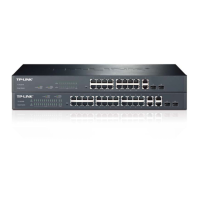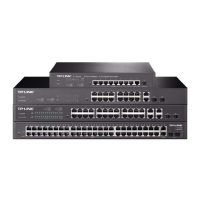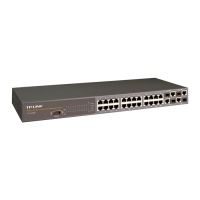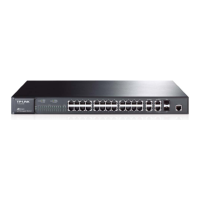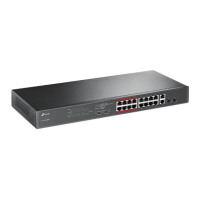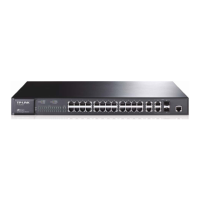Do you have a question about the TP-Link TL-SL2428 and is the answer not in the manual?
Target audience for network managers familiar with IT concepts and terminology.
Explains symbols, menu navigation, and text formatting used in the guide.
Summarizes the guide's chapter structure and content.
Details the TL-SL2428's purpose, performance, and features for workgroups.
Highlights key capabilities like resiliency, Layer 2 switching, QoS, security, and manageability.
Describes the components and indicators found on the front panel of the switch.
Details the rear panel features, including power socket and grounding terminal.
Step-by-step guide on accessing the switch's web management interface.
Introduces the main setup page and configuration options after successful login.
Provides access to view and configure switch's system properties like name, time, and IP.
Covers configuring user accounts, access levels, and user tables for switch management.
Offers functions for managing configuration files, firmware, and system resets.
Details methods to control user access to the web management page via IP, MAC, or port.
Allows configuration of port parameters like speed, duplex, status, and flow control.
Enables monitoring network traffic by forwarding port traffic to a specific mirroring port.
Protects against MAC address attacks by limiting learned MAC addresses per port.
Combines multiple ports into a single high-bandwidth link for load sharing and reliability.
Configures VLANs using the 802.1Q standard for network segmentation.
Illustrates a practical scenario for implementing VLANs and network requirements.
Globally configures Spanning Tree Protocol parameters like priority, hello time, and max age.
Manages Multiple Spanning Tree Protocol instances, regions, and VLAN mappings.
Provides security features like Root Protect and BPDU Protect to prevent STP attacks.
Controls multicast group membership by monitoring IGMP messages between hosts and routers.
Displays and manages multicast IP addresses within the network.
Filters multicast traffic based on IP ranges or port configurations.
Manages traffic classification, mapping, and priority levels based on port, 802.1P, or DSCP.
Configures rate limiting and storm control on ports to manage traffic flow.
Covers global settings, SNMP views, groups, users, and communities for network management.
Sets up trap and inform messages for network events and alerts.
Enables detailed network monitoring and statistics collection via RMON groups.
Monitors CPU and memory utilization to assess switch performance.
Records, classifies, and manages system information and error logs.
Includes Cable Test, Loopback, and Network Diagnose tools for troubleshooting.
Details IEEE standards, transmission rates, media, LEDs, and forwarding rates.
Specifies operating and storage temperature and humidity requirements.
Guides on setting up TCP/IP components on PCs for network connectivity.
Provides definitions for technical terms and protocols used throughout the manual.
Target audience for network managers familiar with IT concepts and terminology.
Explains symbols, menu navigation, and text formatting used in the guide.
Summarizes the guide's chapter structure and content.
Details the TL-SL2428's purpose, performance, and features for workgroups.
Highlights key capabilities like resiliency, Layer 2 switching, QoS, security, and manageability.
Describes the components and indicators found on the front panel of the switch.
Details the rear panel features, including power socket and grounding terminal.
Step-by-step guide on accessing the switch's web management interface.
Introduces the main setup page and configuration options after successful login.
Provides access to view and configure switch's system properties like name, time, and IP.
Covers configuring user accounts, access levels, and user tables for switch management.
Offers functions for managing configuration files, firmware, and system resets.
Details methods to control user access to the web management page via IP, MAC, or port.
Allows configuration of port parameters like speed, duplex, status, and flow control.
Enables monitoring network traffic by forwarding port traffic to a specific mirroring port.
Protects against MAC address attacks by limiting learned MAC addresses per port.
Combines multiple ports into a single high-bandwidth link for load sharing and reliability.
Configures VLANs using the 802.1Q standard for network segmentation.
Illustrates a practical scenario for implementing VLANs and network requirements.
Globally configures Spanning Tree Protocol parameters like priority, hello time, and max age.
Manages Multiple Spanning Tree Protocol instances, regions, and VLAN mappings.
Provides security features like Root Protect and BPDU Protect to prevent STP attacks.
Controls multicast group membership by monitoring IGMP messages between hosts and routers.
Displays and manages multicast IP addresses within the network.
Filters multicast traffic based on IP ranges or port configurations.
Manages traffic classification, mapping, and priority levels based on port, 802.1P, or DSCP.
Configures rate limiting and storm control on ports to manage traffic flow.
Covers global settings, SNMP views, groups, users, and communities for network management.
Sets up trap and inform messages for network events and alerts.
Enables detailed network monitoring and statistics collection via RMON groups.
Monitors CPU and memory utilization to assess switch performance.
Records, classifies, and manages system information and error logs.
Includes Cable Test, Loopback, and Network Diagnose tools for troubleshooting.
Details IEEE standards, transmission rates, media, LEDs, and forwarding rates.
Specifies operating and storage temperature and humidity requirements.
Guides on setting up TCP/IP components on PCs for network connectivity.
Provides definitions for technical terms and protocols used throughout the manual.
| Switch type | Managed |
|---|---|
| Switch layer | L2 |
| Quality of Service (QoS) support | Yes |
| Combo SFP ports quantity | 2 |
| Fast Ethernet (copper) ports quantity | 24 |
| Gigabit Ethernet (copper) ports quantity | 4 |
| Basic switching RJ-45 Ethernet ports quantity | - |
| 10G support | No |
| Networking standards | IEEE 802.1D, IEEE 802.1p, IEEE 802.1Q, IEEE 802.1s, IEEE 802.1w, IEEE 802.3, IEEE 802.3ab, IEEE 802.3i, IEEE 802.3u, IEEE 802.3x, IEEE 802.3z |
| Copper ethernet cabling technology | 1000BASE-T, 100BASE-TX, 10BASE-T |
| Throughput | 9.5 Mpps |
| MAC address table | 8000 entries |
| AC input voltage | 100 - 240 V |
| AC input frequency | 50 - 60 Hz |
| Certification | CE, FCC, RoHS |
| Product color | Black |
| Storage temperature (T-T) | -40 - 70 °C |
| Operating temperature (T-T) | 0 - 40 °C |
| Storage relative humidity (H-H) | 5 - 90 % |
| Operating relative humidity (H-H) | 10 - 90 % |
| Depth | 180 mm |
|---|---|
| Width | 440 mm |
| Height | 44 mm |

